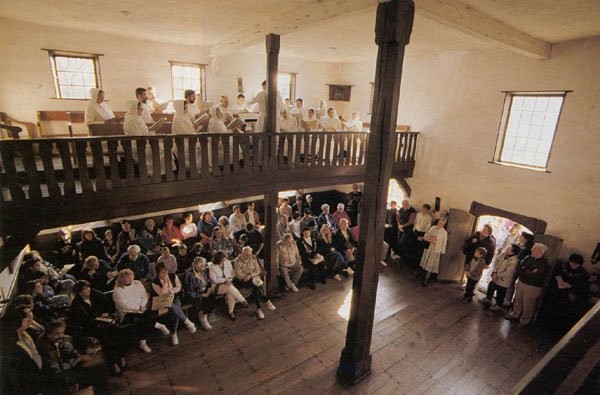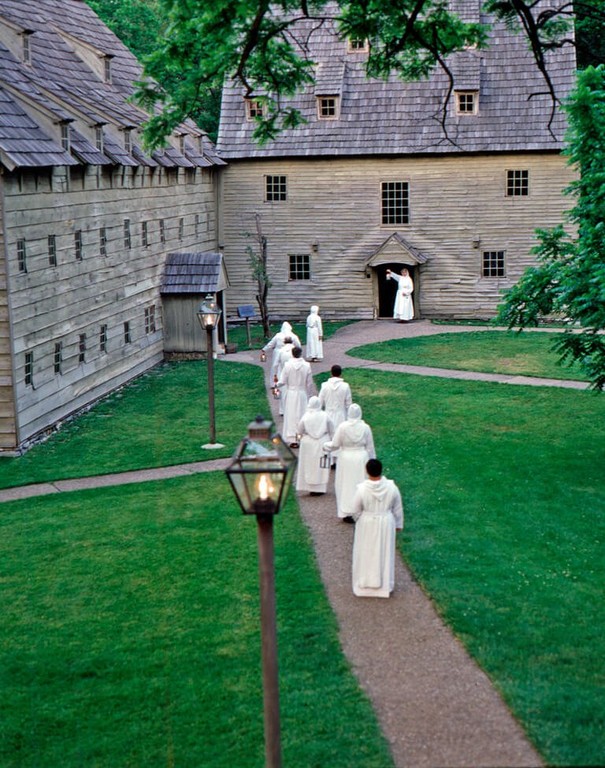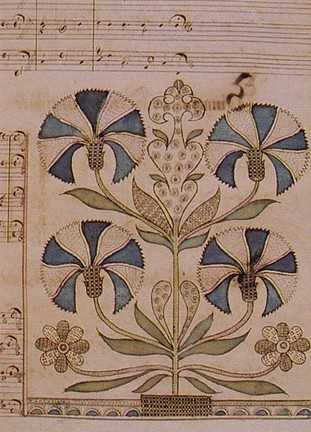Ephrata Cloister
Introduction
Text-to-speech Audio
Images
The Brothers' and Sisters' communal quarters at Ephrata.

The outdoor amphitheater hosts weddings and the Ephrata Choir.

A tour group sits in the house of worship while the choir sings overhead.

It's almost as if you're back in 1750.

An example of Ephrata frakturschriften.

Backstory and Context
Text-to-speech Audio
Conrad Beissel arrived in Pennsylvania, from Germany, in 1720. The self-taught theologian quickly joined the German Baptists (today’s Church of the Brethren) and became a pastor in Conestoga. He developed a small following, yet sought the ultimate form of religious isolation, hermitage, along the banks of Cocalico Creek. However, he continued to preach and write from this location and his followers soon joined him. They quickly formed a Protestant splinter group known as the Seventh Day Baptists and named their community Ephrata after the Biblical location of Ephrath.
The Ephrata community sought to more closely bind their souls to God by practicing extreme forms of self-denial, discipline and ascetism. They strictly controlled what they ate, how much they slept, practiced celibacy, observed the Sabbath on Saturday and were millennialists who believed the end of days were imminent. Their dwellings grew from small cabins to large, Medieval-style communal buildings separated by gender. They also became an almost wholly self-contained community as they built saw, grist, paper and linseed oil mills, a tannery, orchard, gardens, bakery, printing press and book bindery.
The First Great Awakening increased interest in the cloister and swelled their numbers, especially when Beissel stated that celibacy was recommended, not required. Soon, married couples joined the congregation while residing in their own homes outside the cloister. Singing became central to the congregation’s spirituality and members began to compose their own hymns, to include Beissel who wrote almost 500. Eventually, they began to publish hymnals, with the first being published in 1747.
Other members practiced a German form of pen and ink art or calligraphy known as fraktur or frakturschriften. On community produced linen paper, members wrote religious poetry and hymns decorated with floral illustrations and these collections were also published. One of the works they published was the Martyrs’ Mirror, a 1,500-page (making it the largest colonial book published) history of Christian martyrs.
As with most religious sects, especially those espousing celibacy, Ephrata’s membership numbers began to decline, precipitated by Beissel’s death in 1768. Householders continued to operate the printing shop until the 1830s and worshiped at Ephrata until 1934. The state acquired the buildings and property in 1941. The Pennsylvania Historical Commission, now the Pennsylvania Historical and Museum Commission, restored the 11 original buildings and opened the property to the public. The local community also created the Ephrata Cloister Associates, an organization that assists in operating and maintaining the cloister. Today, the 50,000 annual visitors tour the 1741 Brothers’ House and 1743 Sisters’ House, among other historical buildings on site. There is also a visitor’s center and museum, as well as two on-site cemeteries. Conrad Beissel and his successor, Peter Allen, are both interred in the cemetery now called God’s Acre.
Sources
Bradley, John. "Pushing William Penn's 'Holy Experiment' to its Limits: Ephrata Cloister." Pennsylvania Heritage. Fall, 1996. Accessed January 26, 2019. http://www.phmc.state.pa.us/portal/communities/pa-heritage/william-penn-holy-experiment-ephrata-cloister.html
Gordon, Ronald. "The Ephrata Cloister: Conrad Beissel and his Communal Experiment." Church of the Brethren Network. February, 1996. Updated March, 2016. Accessed January 26, 2019. https://www.cob-net.org/cloister.htm
Fox, Emily and Lindley Homol. "Wooden Pillows and Celibacy: Life at the Cloister." Pennsylvania Center for the Book. Spring, 2009. Accessed January 26, 2019. https://pabook.libraries.psu.edu/literary-cultural-heritage-map-pa/feature-articles/wooden-pillows-and-celibacy-life-cloister
Lenz, Darin. "History, Theology, and Interpretation: The Ephrata Cloister, a Case Study in Public History." Villanova.edu. 2002. Accessed January 26, 2019. https://concept.journals.villanova.edu/article/view/317/280
